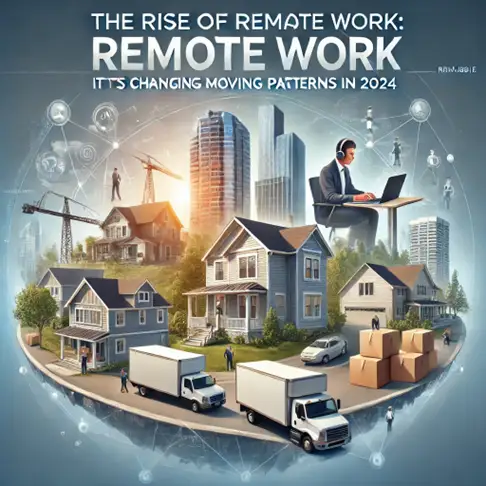
How Remote Work is Changing Moving Trends in 2024
Introduction
The COVID-19 pandemic has dramatically shifted the landscape of work, making remote work not just a temporary measure but a lasting change. This transition has had profound effects on where and how people choose to live. As we move through this year, the impact of remote work on housing continues to grow, influencing decisions to move for remote work and reshaping moving trends in 2024 across urban and suburban landscapes alike.
Changing Moving Patterns

Recent studies highlight the significant impact of remote work on relocation decisions. According to a survey conducted by Upwork, an estimated 14 to 23 million Americans plan to move due to remote work opportunities. This change isn’t just about new addresses; it’s about embracing new lifestyles and economic realities of moving trends in 2024. A report from Coworking Insights notes that remote work has fueled an increase in demand for suburban and rural living as people seek more space and affordable living (Axonify).
Trend: Urban Exodus to Suburban and Rural Areas

One of the most noticeable trends is the migration from urban centers to suburban and rural regions. Data from the U.S. Census Bureau shows a clear population decline in major cities like New York and San Francisco, while smaller towns and suburban areas are seeing population booms. This shift is largely driven by remote workers seeking more space, affordability, and a better quality of life (Worktually) (Axonify).
Expert Insight: The New Criteria for Choosing a Home

Zillow’s Chief Economist, Svenja Gudell, explains, “Remote work has redefined the criteria people use when choosing a home. Proximity to the workplace is no longer a priority. Instead, factors like space, internet connectivity, and community amenities are taking precedence”.
Laurie Goodman, Urban Institute: “As remote work continues to rise, we expect to see more diverse housing preferences, with individuals prioritizing space and affordability over proximity to urban centers.”
Practical Tips for Remote Workers Planning to Move

If you’re considering a move due to remote work, here are some practical tips to ensure a smooth transition:
- Evaluate Internet Connectivity: High-speed internet is crucial for remote work. Research the availability and reliability of internet services in your prospective new location. Tools like Speedtest by Ookla can help you check internet speeds in specific areas.
- Consider Cost of Living: Compare the cost of living in your current city versus your new one. Tools like Numbeo can help you assess expenses such as housing, groceries, and healthcare. Additionally, consider local taxes, which can vary significantly from one state or region to another.
- Plan Your Workspace: Ensure your new home has adequate space for a dedicated home office. Natural light, minimal noise, and ergonomic furniture can enhance productivity. Look for homes with extra rooms or spaces that can be easily converted into a functional workspace.
- Understand Tax Implications: Moving to a new state or city can have tax implications. Some states have no income tax, while others have high property taxes. Consulting with a tax professional before your move can help you understand how relocation will affect your finances.
- Choose the Right Moving Company: Selecting a reputable moving company is essential. Look for companies with experience in long-distance moves and positive customer reviews. Consider getting multiple quotes to ensure you’re getting the best deal, and check if the company offers insurance for your belongings.
- Explore Community and Amenities: Research the community and amenities available in your new location. Consider factors like proximity to parks, schools, healthcare facilities, and shopping centers. If possible, visit the area beforehand to get a feel for the neighborhood.
- Consider Climate and Weather: The climate of your new location can impact your lifestyle and even your work. Ensure that your new home is equipped to handle the local weather conditions, whether that means ensuring good heating and cooling systems or preparing for seasonal weather changes.
Human Interest Story: From City to Countryside
The story of Jason and Michelle Swindon, featured in The New York Times, exemplifies the impact of remote work on moving patterns. They moved from a small apartment in San Francisco to a larger home in Boise, Idaho. Jason shares, “The move has significantly improved our work-life balance. We now have a home office, a backyard for our kids, and a lower cost of living” (Worktually).
The Economic Impact of Remote Work Moves

The mass migration driven by remote work has far-reaching economic implications. Urban areas experiencing population declines are seeing reduced demand for housing, leading to lower rental prices. Conversely, rural and suburban regions are witnessing a surge in real estate demand, driving up property values. According to Zillow, home prices in suburban areas increased by 10% on average in the past year alone.
The Role of Technology in Remote Work and Moving

Technology plays a crucial role in supporting remote work and facilitating moves. Tools like virtual reality for home tours and AI in relocation services are making it easier for people to find and move into new homes. These advancements are expected to continue evolving, providing more options for remote workers.
Conclusion

The rise of remote work is reshaping moving trends in 2024, offering people the freedom to choose where they live based on personal preferences rather than proximity to the workplace. As these trends continue, the impact of remote work on housing and the decision to move for remote work will have lasting effects on both urban and suburban landscapes, as well as the broader economy. It will be fascinating to observe how these changes play out in the years to come.
References
- Upwork Survey: Upwork’s Future Workforce Report
- S. Census Bureau: Population Data
- Zillow Home Price Index: Zillow Research
- Numbeo Cost of Living: Numbeo
- The New York Times: “How the Pandemic Has Changed the Way We Move”
- Axonify: “The Evolution of Remote Work: Trends and Predictions for 2024”
- Worktually: The Future Of Remote Work: Predictions And Trends For 2024 And Beyond
Popular on Tophelpers

Beware of Moving Scams: Nationwide Crackdown Announced by U.S. Officials

What Customers Will Love About TopHelpers – Movers Hiring Platform
